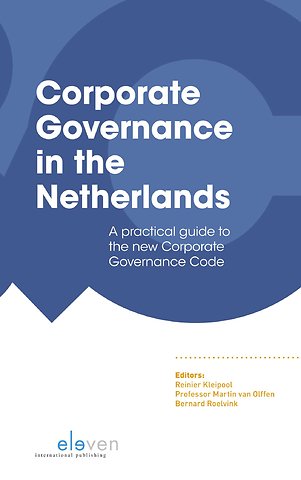Corporate Governance in the Netherlands
A practical guide to the new Corporate Governance Code (PDF-Download)
E-book Pdf met watermerkbeveiliging Engels 2018 1e druk 9789462748323Samenvatting
Corporate governance in the Netherlands is beginning to develop its own history. On 8 December 2016, the third Dutch Corporate Governance Code was published. The 2016 Code introduces many new ideas and responds to current developments in corporate governance issues.
The Code is not static – it follows the dynamics of our society. The most important new themes in the 2016 Code are long-term value creation and culture. This book covers those themes in detail, particularly where they resonate in other areas, such as risk management. In addition, this book addresses other updated items of the Code.
This book also comments on the principles and best practice provisions of the Code and clarifies its structure and background.
Trefwoorden
corporate governance toezicht bestuur wetgeving nederland risicomanagement transparantie compliance aandeelhouders beloningsbeleid cultuur ondernemingsrecht verantwoording strategie management organisatie leiderschap ethiek controle naslagwerk financieel management accountancy besluitvorming beleid
Trefwoorden
Specificaties
Lezersrecensies
Inhoudsopgave
U kunt van deze inhoudsopgave een PDF downloaden
Introduction to the History, Background and Key Provisions of the New Code 13
1 Long-Term Value Creation 25
1.1 Long-Term Value Creation 25
1.1.1 Long-Term Value Creation Strategy 27
1.1.2 Involvement of the Supervisory Board 29
1.1.3 Role of the Supervisory Board 30
1.1.4 Accountability of the Management Board 31
1.2 Risk Management 32
1.2.1 Risk Assessment 34
1.2.2 Implementation 36
1.2.3 Monitoring of Effectiveness 37
1.3 Internal Audit Function 38
1.3.1 Appointment and Dismissal 39
1.3.2 Assessment of the Internal Audit Function 40
1.3.3 Internal Audit Plan 40
1.3.4 Performance of Work 42
1.3.5 Reports of Findings 42
1.3.6 Absence of an Internal Audit Department 43
1.4 Risk Management Accountability 44
1.4.1 Accountability to the Supervisory Board 45
1.4.2 Accountability in the Management Report 46
1.4.3 Statement by the Management Board 47
1.5 Role of the Supervisory Board 50
1.5.1 Duties and Responsibilities of the Audit Committee 51
1.5.2 Attendance of the Management Board, Internal Auditor and External Auditor at Audit Committee Consultations 53
1.5.3 Audit Committee Report 54
1.5.4 Supervisory Board 55
1.6 Appointment and Assessment of the Functioning of the External Auditor 56
1.6.1 Functioning and Appointment 56
1.6.2 Informing the External Auditor about Their Functioning 57
1.6.3 Engagement 58
1.6.4 Accountability 58
1.6.5 Departure of the External Auditor 59
1.7 Performance of the External Auditor’s Work 60
1.7.1 Provision of Information to the External Auditor 61
1.7.2 Audit Plan and External Auditor’s Findings 61
1.7.3 Publication of Financial Reports 62
1.7.4 Consultations with the External Auditor outside the Management Board’s Presence 63
1.7.5 Examination of Discussion Points Arising between the External Auditor and the Management Board 63
1.7.6 External Auditor’s Attendance of Supervisory Board Meetings 64
2 Effectiveness of Management and Supervision 65
2.1 Composition and Size 65
2.1.1 Profile 66
2.1.2 Personal Information 67
2.1.3 Executive Committee 68
2.1.4 Expertise 69
2.1.5 Diversity Policy 70
2.1.6 Accountability about Diversity 71
2.1.7 Independence of the Supervisory Board 73
2.1.8 Independence of Supervisory Board Members 75
2.1.9 Independence of the Chairman of the Supervisory Board 78
2.1.10 Accountability Regarding Supervisory Board Member Independence 79
2.2 Appointment, Succession and Evaluation 79
2.2.1 Appointment and Reappointment Periods – Management Board Members 80
2.2.2 Appointment and Reappointment Periods – Supervisory Board Members 82
2.2.3 Early Retirement 84
2.2.4 Succession 86
2.2.5 Duties of the Selection and Appointment Committee 86
2.2.6 Evaluation by the Supervisory Board 88
2.2.7 Evaluation of the Management Board 89
2.2.8 Evaluation Accountability 90
2.3 Organization of the Supervisory Board and Reports 90
2.3.1 Supervisory Board Terms of Reference 91
2.3.2 Establishment of Committees 92
2.3.3 Committees’ Terms of Reference 93
2.3.4 Composition of the Committees 94
2.3.5 Committee Reports 95
2.3.6 Chairman of the Supervisory Board 96
2.3.7 Vice-Chairman of the Supervisory Board 98
2.3.8 Delegated Supervisory Board Member 99
2.3.9 Temporary Management Board Function of a Supervisory Board Member 100
2.3.10 Company Secretary 100
2.3.11 Report of the Supervisory Board 102
2.4 Decision-Making and Functioning 102
2.4.1 Stimulating Openness and Accountability 103
2.4.2 Other Positions 104
2.4.3 Point of Contact for the Functioning of Supervisory Board and Management Board Members 106
2.4.4 Attendance at Supervisory Board Meetings 106
2.4.5 Induction Programme for Supervisory Board Members 107
2.4.6 Development 107
2.4.7 Information Safeguards 108
2.4.8 Supervisory Board Members’ Responsibility for Obtaining Information 108
2.4.9 Obtaining Information from Officers and External Parties 110
2.5 Culture 110
2.5.1 Management Board’s Responsibility for Culture 112
2.5.2 Code of Conduct 113
2.5.3 Employee Participation 114
2.5.4 Accountability Regarding Culture 115
2.6 Misconduct and Irregularities 116
2.6.1 Procedure for Reporting Actual or Suspicion of Misconduct or Irregularities 117
2.6.2 Informing the Chairman of the Supervisory Board 118
2.6.3 Notification by the External Auditor 119
2.6.4 Oversight by the Supervisory Board 119
2.7 Preventing Conflicts of Interest 120
2.7.1 Preventing Conflicts of Interest 121
2.7.2 Terms of Reference 122
2.7.3 Reporting 123
2.7.4 Accountability Regarding Transactions: Management Board and Supervisory Board Members 126
2.7.5 Accountability Regarding Transactions: Majority Shareholders 128
2.7.6 Personal Loans 129
2.8 Takeover Situations 129
2.8.1 Supervisory Board Involvement 130
2.8.2 Informing the Supervisory Board about Request for Inspection by Competing Bidder 131
2.8.3 Management Board’s Position on a Private Bid 133
3 Remuneration 135
3.1 Remuneration Policy – Management Board 135
3.1.1 Remuneration Policy Proposal 136
3.1.2 Remuneration Policy 137
3.1.3 Remuneration – Executive Committee 141
3.2 Determining Management Board Remuneration 141
3.2.1 Remuneration Committee’s Proposal 142
3.2.2 Management Board Members’ Views on Their Own Remuneration 143
3.2.3 Severance Payments 144
3.3 Remuneration of Supervisory Board Members 144
3.3.1 Time Spent and Responsibility 145
3.3.2 Remuneration of Supervisory Board Members 146
3.3.3 Share Ownership 146
3.4 Accountability for Implementation of Remuneration Policy 147
3.4.1 Remuneration Report 148
3.4.2 Agreement of Management Board Member 149
4 The General Meeting 151
4.1 The General Meeting 151
4.1.1 Supervisory Board Supervision 154
4.1.2 Proper Conduct of Business at Meetings 155
4.1.3 Agenda 156
4.1.4 Proposal for Approval or Authorization 159
4.1.5 Shareholder’s Explanation When Exercising the Right to Put Items on the Agenda 159
4.1.6 Placing of Items on the Agenda by Shareholders 161
4.1.7 Stipulation of the Response Time 162
4.1.8 Attendance of Members Nominated for the Management Board or Supervisory Board 163
4.1.9 External Auditor’s Attendance 163
4.1.10 General Meeting’s Report 164
4.2 Provision of Information 165
4.2.1 Substantiation of Invocation of Overriding Interest 166
4.2.2 Policy on Bilateral Contacts with Shareholders 167
4.2.3 Meetings and Presentations 168
4.2.4 Posting Information in a Separate Section of the Website 169
4.2.5 Management Board Contacts with Press and Analysts 169
4.2.6 Outline of Anti-takeover Measures 170
4.3 Casting Votes 170
4.3.1 Voting as Deemed Fit 171
4.3.2 Providing Voting Proxies or Voting Instructions 172
4.3.3 Cancelling the Binding Nature of a Nomination or Dismissal 173
4.3.4 Voting Right on Financing Preference Shares 174
4.3.5 Publication of Institutional Investors’ Voting Policy 175
4.3.6 Report on the Implementation of Institutional Investors’ Voting Policy 176
4.4 Issuing Depositary Receipts for Shares 176
4.4.1 Trust Office Board 179
4.4.2 Appointment of Board Members 179
4.4.3 Board Appointment Period 180
4.4.4 Attendance of the General Meeting 181
4.4.5 Exercise of Voting Rights 181
4.4.6 Periodic Reports 183
4.4.7 Contents of the Reports 183
4.4.8 Voting Proxies 184
5 The One-Tier Governance Structure 187
5.1 One-Tier Governance Structure 187
5.1.1 Composition of the Management Board 189
5.1.2 Chairman of the Management Board 190
5.1.3 Independence of the Chairman of the Management Board 190
5.1.4 Composition of Committees 191
5.1.5 Accountability for Supervision by Non-executive Directors 192
Anderen die dit e-book kochten, kochten ook
Rubrieken
- advisering
- algemeen management
- coaching en trainen
- communicatie en media
- economie
- financieel management
- inkoop en logistiek
- internet en social media
- it-management / ict
- juridisch
- leiderschap
- marketing
- mens en maatschappij
- non-profit
- ondernemen
- organisatiekunde
- personal finance
- personeelsmanagement
- persoonlijke effectiviteit
- projectmanagement
- psychologie
- reclame en verkoop
- strategisch management
- verandermanagement
- werk en loopbaan








